Here I have things and stuff I like. I'm 18 years old pup who loves space and sciece. You may find some fascinating things here.
41 posts
Latest Posts by thestarblaster-blog - Page 2

“Super Moon” November 14, 2016

Milky Way over Provence, France
js

Pluto, 2006 (Red Filter).
Credit: NASA, ESA, A Stern, H Weaver and the HST Pluto Companion Search Team

NGC 6888: The Crescent Nebula by Michael Miller, Jimmy Walker

The Cone Nebula from Hubble
js

47 Tucanae

Milky Way over Morganville, New Jersey
js








If there is magic on this planet, it is contained in water :D


Today in Science History: “In 2002, the first national law prohibiting ‘light pollution’ went into effect. The Czech Republic became the first nation to outlaw excess outdoor light.”
Video
Solar System: Things to Know This Week
Our solar system is huge, let us break it down for you. Here are a few things to know this week:
1. Juno Eyes on Jupiter

After a journey of more than five years, the Juno spacecraft is ready for its detailed look at Jupiter—arrival date: July 4. Using Eyes on the Solar System and data from the Juno flight team, you can take a virtual ride onboard the spacecraft in the “Eyes on Juno” simulation.
2. Taking a Spacecraft for a Spin

Preparations for the launch of the OSIRIS-REx asteroid mission are spinning up, literally. Here, the spacecraft can be seen rotating on a spin table during a weight and center of gravity verification test at our Kennedy Space Center. Liftoff is scheduled for Sept. 8. This spacecraft will travel to a near-Earth asteroid called Bennu and bring a small sample back to Earth for study.
3. Long-Range (Or at Least Long-Distance) Weather Report

Our Mars Reconnaissance Orbiter acquires a global view of the red planet and its weather every day. Last week, dust storms continued along the south polar ice cap edge. Northern portions of Sirenum, Solis, and Noachis also experienced some local dust-lifting activity. A large dust storm propagated eastward over the plains of Arcadia at the beginning of the week, but subsided just a few days later over Acidalia.
4. Hello from the Dark Side

The New Horizons spacecraft took this stunning image of Pluto only a few minutes after closest approach in July 2015, with the sun on the other side of Pluto. Sunlight filters through Pluto’s complex atmospheric haze layers. Looking back at Pluto with images like this gives New Horizons scientists information about Pluto’s hazes and surface properties that they can’t get from images taken on approach.
5. A Titanic Encounter

On June 7, our Cassini orbiter will fly very close by Saturn’s giant, haze-shrouded moon Titan. Among the targets of its observations will be the edge of the vortex that swirls in Titan’s thick atmosphere near its south pole.
Want to learn more? Read our full list of the 10 things to know this week about the solar system HERE.
Make sure to follow us on Tumblr for your regular dose of space: http://nasa.tumblr.com

“You’re capable of such beautiful dreams, and such horrible nightmares. You feel so lost, so cut off, so alone, only you’re not. See, in all our searching, the only thing we’ve found that makes the emptiness bearable, is each other.” - Carl Sagan, Contact